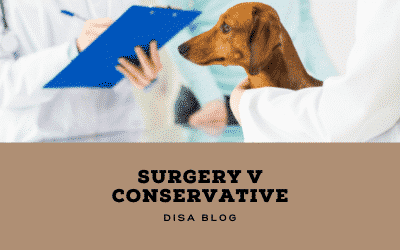I have taken two hounds through both conservative and surgical pathways (both Grade 5) and have an open mind to both; it primarily comes down to the dog, the preparedness of the owner and most importantly what access you have to services in your area that are familiar with this disease and who are willing to work proactively alongside you and your dog. Trust me, not all professionals know or understand IVDD!
When it comes to IVDD in Dachshunds – every dog, every case and every owner’s expectations are different. It became clear to me as I have navigated my way through the IVDD minefield over the last 7 years, that there is no right or wrong. Both surgical and conservative therapies come with caveats, and despite what science tells us, these little hounds are truly amazing and never say never. Ultimately, it’s what you as an owner is prepared to accept and manage moving forward.
So, let’s weigh up the options –
**Taking the guesswork out of a diagnosis and opting for a CT/MRI/Myelogram**
Yes, you can have high-resolution imaging performed (NOT AN X-RAY!) to find out what is really going on internally and yes, surgeons will in most cases suggest a surgical pathway, however, it’s what you as an owner is prepared to accept and manage moving forward.
Surgery
In some instances, surgery will be the only choice for a positive outcome e.g., for your dog to walk again and live a new normal life. It’s often determined by a Grading scale which is detailed on our website. 1 being minor and 5 being the highest.
The downside is that surgery repairs the affected disc/s that have ruptured/herniated at the time of the episode and, as is seen often, there is no guarantee that further discs won’t calcify and rupture/herniate in the future. Sadly, 25% of hounds will relapse following IVDD surgery.
Conservative
There are also cases whereby surgery isn’t possible or not the preferred pathway. This can be cost-related, location to specialist centres or even choice. Conservative treatment is where owners embrace a more “holistic” approach to their dog’s IVDD management, usually performed in conjunction with a veterinary professional (or a holistic vet) who understands IVDD (not all vets do!) and accompanied by a qualified alternative therapist proficient in various modalities.
This approach requires patience and time. It’s all about healing and pain management where nature is allowed to take its course and the affected area is encouraged to heal through extended rest and accompanied with gentle modalities such as acupuncture, laser and supplements. It requires strict crate rest and dedication by the owner and isn’t for the faint-hearted. Once again, there is no guarantee that there won’t be further issues in the future. Once a diseased spine, always a diseased spine.
Forewarned is forearmed
It’s 2021, information about IVDD is freely available however don’t let Dr Google and Facebook Groups become your enemy and overwhelm you.
My advice is to take a deep breath, weigh up your options, make your decision and run with it.
As I have already mentioned, there really is no right or wrong, only what you as an owner are prepared to embrace and adopt. Of course, the DISA family will be there to have your back, no matter your decision.
Written by Chrissy Davis – DISA Founder

